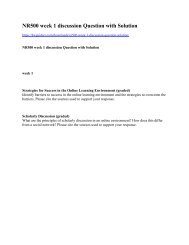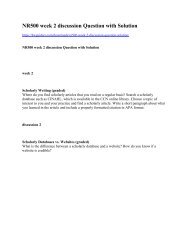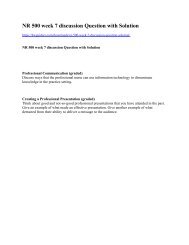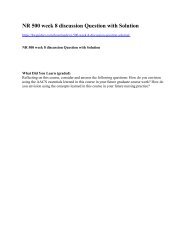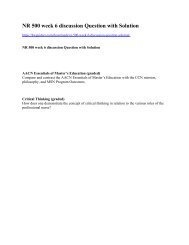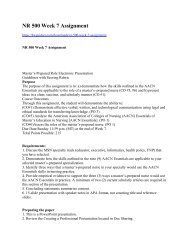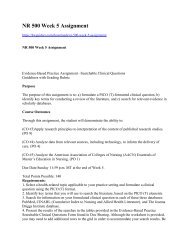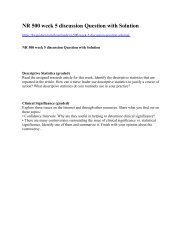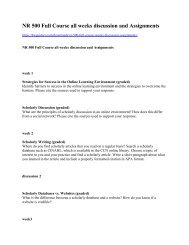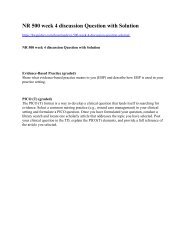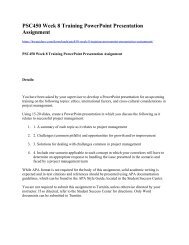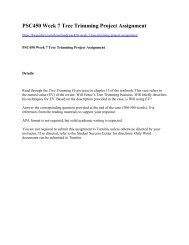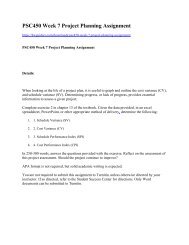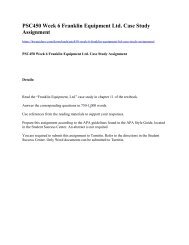NR305 Full Course all discussions
You also want an ePaper? Increase the reach of your titles
YUMPU automatically turns print PDFs into web optimized ePapers that Google loves.
<strong>NR305</strong> <strong>Full</strong> <strong>Course</strong> <strong>all</strong> <strong>discussions</strong>, Assignments and course<br />
project<br />
https://hwguiders.com/downloads/nr305-full-course-<strong>discussions</strong>-assignments-course-project/<br />
<strong>NR305</strong> <strong>Full</strong> <strong>Course</strong> <strong>all</strong> <strong>discussions</strong>, Assignments and course project<br />
Devry <strong>NR305</strong> Week 1 Discussion DQ 1 & DQ 2<br />
DQ 1<br />
As the school nurse working in a college health clinic, you see many opportunities to promote<br />
health. Maria is a 40-year-old Hispanic woman who is in her second year of nursing school. She<br />
complains of a 14-pound weight gain since starting school and is afraid of what this will do to<br />
both her appearance and health if the trend continues. After doing her history, you learn that she<br />
is an excellent cook and she and her family love to eat foods that reflect their Hispanic heritage.<br />
She is married with two school-age children. She is in class a total of 15 hours per week, plus 12<br />
hours of labs and clinical. She maintains the household essenti<strong>all</strong>y by herself and does <strong>all</strong> the<br />
shopping, cooking, cleaning, and chauffeuring of the children. She states that she is lucky to get<br />
six hours of sleep per night, but that is okay with her. She lives one hour from campus and<br />
commutes each day. Using.healthypeople.gov/”>Healthy People 2020and your text as a guide:<br />
1. What additional information would you like to gather from Maria?<br />
2. What are Maria’s real and potential health risks?<br />
3. Why is Maria’s culture important when obtaining the health assessment?<br />
4. Pick one of Maria’s health risks. Would you classify Maria’s problem as firstlevel<br />
priority, second-level priority, third-level priority, or a collaborative<br />
problem? What would be one reasonable short-term goal for this risk?<br />
DQ 2
Understanding cultural phenomena is essential to the completion of an accurate and holistic<br />
health assessment. Please review a cultural group from Table 2-3 (p. 20) from your text and<br />
describe the cultural differences pertinent to that group (you may have to do some additional<br />
searching). Remember, the table may not include <strong>all</strong> cultural groups. Let’s try to include <strong>all</strong> the<br />
countries within the groups listed in the discussion, so please do not choose a group that has<br />
already been done. To expedite this, please use the group name in the title of your post.<br />
Devry <strong>NR305</strong> Week 2 Discussion DQ 1 & DQ 2<br />
DQ 1<br />
John, a 46-year-old African American male presents for admission to your hospital for hemi<br />
colectomy for colon polyps. He is complaining of chronic back pain. Patient is on disability from<br />
work-related injury. History of two previous back surgeries with relief of numbness in RLE, but<br />
pain has not been relieved. His current medications include Methadone, Neurontin, and Norco.<br />
John states he takes Tylenol PM every night in addition to his prescribed medications. John is a<br />
smoker and smokes 1 PPD. John confides in you that he is considering a spinal cord stimulator<br />
for the chronic pain.<br />
<br />
<br />
<br />
<br />
What risk factors does John have for risk of opioid withdrawal during this<br />
hospitalization?<br />
Is there a stigma connected to being disabled and/or methadone?<br />
Does the nurse need to be concerned about acetaminophen use?<br />
What are the differences in acute and chronic pain?<br />
DQ 2
Red Yoder is an 80-year-old farmer who lives alone in the farmhouse where he grew up. It is<br />
located 20 miles outside of town. Red has been a widower for 10 years. Red rarely cooks for<br />
himself and mainly eats packaged or processed foods. His son, Jon, manages the farm now, but<br />
Red is still involved in the decision making. Red’s current medical problems include insulindependent<br />
diabetes complicated by an open foot wound. He also has some incontinence and<br />
difficulty sleeping.<br />
Red is awaiting a visit from the home health nurses. He relates that he has an open wound on his<br />
big toe that developed after walking in a new pair of shoes. When his daughter-in-law, Judy, saw<br />
the wound, she c<strong>all</strong>ed the family doctor, who suggested a visit by the wound care nurse, who<br />
works with the home health agency. Red agreed as long as his VA benefits cover the costs. Red<br />
is aware that his son and daughter-in-law have concerns about him living alone, but Red insists<br />
that while he needs a little help from Jon and Judy at times, he is still capable of caring for<br />
himself.<br />
<br />
<br />
<br />
<br />
<br />
<br />
What are Red’s strengths?<br />
What are your concerns for this patient?<br />
What is the cause of your concern?<br />
What information do you need?<br />
What are you going to do about it?<br />
What is Red experiencing?<br />
Devry <strong>NR305</strong> Week 3 Discussion DQ 1 & DQ 2<br />
DQ 1<br />
General Survey and Health History (graded)<br />
Casey is a 17-year-old high school student admitted to the ER with a compound fracture of the<br />
left leg obtained when f<strong>all</strong>ing at the local skateboard park while practicing for a national<br />
competition. He has never been hospitalized before. His mother has been notified and is on her<br />
way. The EMTs gave him morphine and he reports his pain level as “okay.”<br />
<br />
What part of the interview and examination can be done prior to his mother’s arrival?
As you enter the room for the first time, what should you observe as part of the general<br />
survey?<br />
As you complete his history, what areas are especi<strong>all</strong>y important?<br />
What are the important developmental considerations for Casey?<br />
DQ 2<br />
As you rec<strong>all</strong>, our older patient, Red Yoder, with whom you met in Week 2, is preparing for<br />
discharge from the hospital since his wound required intravenous antibiotics and wound care. Jon<br />
(Red’s son) thinks that Red should move in with him for now, but Red is sure he is able to care<br />
for himself and insists that his confusion was due to the fact that he did not have his glasses or<br />
hearing aids for the last week. You have identified discharge teaching needs for him. This<br />
morning, however, in report the night nurse has shared “Patient is alert and oriented; vital signs<br />
stable. Fasting blood sugar this morning is 118. Red had his usual night of sleep. He was up<br />
several times to go to the bathroom. Since his catheter was removed yesterday, he has urgency<br />
incontinence. He is able to ambulate to the bathroom, but he is weak.” You administer his AM<br />
medications and note that he has some difficulty grasping the water cup and needs assistance<br />
holding it. Mr. Yoder states he needs to go to the bathroom and when you assist him up to his<br />
feet, he seems a bit unsteady. He takes several steps and tells you he needs to sit down.<br />
<br />
<br />
<br />
<br />
How much, if any, functional decline has occurred while Red was hospitalized and how<br />
will this affect his recovery?<br />
What are the risks and benefits of Red living with Jon and Judy?<br />
What are the risks or benefits of Red living at home after discharge? If services are in<br />
place, would it be considered a safe discharge?<br />
Considering <strong>all</strong> aspects of aging, what are the best and appropriate options for Red at this<br />
time?<br />
Devry <strong>NR305</strong> Week 4 Discussion DQ 1 & DQ 2<br />
DQ 1
William Smaile is a 65-year-old man who presents to his general practitioner’s office with<br />
complaint of right forearm swelling, redness, and pain. He was recently discharged from the<br />
hospital where he had been receiving intravenous antibiotics for a respiratory infection.<br />
Subjective Data<br />
<br />
<br />
Pain level is a 5/10 location = right forearm, aching<br />
Retired foreman at a local industrial plant<br />
Objective Data<br />
Vital signs: BP 150/68, T 37 degrees Centigrade, P 80, R 16<br />
<br />
<br />
<br />
Swelling and reddened right forearm, warm to touch<br />
+ pulses, brachial and radial (R)<br />
+2 capillary refill fingers right hand<br />
1. What other assessments should be included for this patient?<br />
2. From your readings, what is the most probable cause of the swelling?<br />
3. What is your nursing diagnosis?<br />
4. What would be included in the nursing care plan?<br />
5. What interventions might be included in the plan of care for this patient?<br />
DQ 2<br />
Assessment of the Head, Neck, and Regional Lymphatics (graded)<br />
Describe the characteristics of the lymph nodes associated with the disease states listed below:<br />
(Choose one.)<br />
<br />
<br />
<br />
Acute infection<br />
Chronic inflammation<br />
Cancer
week 5<br />
DQ 1<br />
Kevin Valeri is a 64-year-old man who presents to the gastroenterologist’s office with<br />
constipation and abdominal bloating.<br />
Subjective Data<br />
<br />
<br />
<br />
<br />
<br />
Pain level is a 4/10 location = right lower abdomen<br />
Retired Engineer<br />
States he has been going to the bathroom with the help of laxatives, but not having<br />
regular movements<br />
Appetite is decreased, some nausea<br />
PMH: depression, anxiety, chronic constipation<br />
Objective Data<br />
Vital signs: T 37 degrees Centigrade, P 64, R 16, BP 124/58<br />
<br />
<br />
Bowel sounds hypoactive in <strong>all</strong> four quadrants<br />
Medications: Lamictal 200mg daily, Lexapro 10 mg daily<br />
DQ 2<br />
Weight = 210 lbs, last visit weight = 195<br />
1. What other assessments should be included for this patient?<br />
2. What questions should the nurse ask with regard to the abdominal pain?<br />
3. From the readings, subjective data, and objective data, what is the most probable cause of<br />
the abdominal pain?<br />
4. What should be included in the plan of care?<br />
5. What interventions should be included in the plan of care for this patient?<br />
Choose one topic and respond:
Discuss three ways of creating an environment that provides psychological comfort for<br />
both patient and practitioner when conducting an examination and assessment of the<br />
Genitourinary system.<br />
Discuss medications that can affect the sexual performance of an aging adult male,<br />
possibly resulting in withdrawal from sexual activity.<br />
Discuss circumcision and the arguments for and against it. Discuss its associated<br />
religious connections.<br />
week 6<br />
DQ 1<br />
Georgina Graves is a 42-year-old female who presents to the provider’s office with fatigue.<br />
Subjective Data<br />
<br />
<br />
<br />
<br />
<br />
<br />
<br />
PMH: none, (except gynecological issues)<br />
Significant family history of heart disease<br />
Fatigue started about 2 months ago, getting worse<br />
Relieved with rest, exacerbated with activity<br />
Denies chest pain<br />
C/O shortness of breath on exertion<br />
Smoker 1 PPD<br />
Objective Data<br />
Vital signs: T 37 P 100 R 18 BP 110/54<br />
<br />
Lungs: clear<br />
O2 Sat = 94%<br />
<br />
Skin = cool to touch
CV = heart rate regular, positive peripheral pulses, ECG = intermittent complete left<br />
bundle branch block (New Finding)<br />
Edema<br />
Medications: Premarin 0.3 mg po/day<br />
1. What other questions should the nurse ask about the fatigue?<br />
2. What other assessments would be necessary for this patient?<br />
3. What are some causes of fatigue?<br />
4. What should be included in the plan of care?<br />
5. Based on the readings, what is the most likely cause of fatigue for this patient?<br />
DQ 2<br />
Nelson Carson is a 62-year-old man who presents to his private practitioner’s office with a<br />
hacking, raspy cough.<br />
Subjective Data<br />
<br />
<br />
<br />
<br />
<br />
PMH: HTN, CAD<br />
Cough is productive, bringing up green, thick phlegm<br />
Runny nose, sore throat<br />
No history of smoking or seasonal <strong>all</strong>ergies<br />
Complains of fatigue<br />
Objective Data<br />
Vital signs: T 37 P 72 R 14 BP 134/64<br />
<br />
Lungs: + Rhonchi bilateral upper lobes, wheezes<br />
O2 Sat = 98%<br />
Medications: Metoprolol 25 mg per day, ASA 325 mg/daily
1. What other questions should the nurse ask about the cough?<br />
2. What nursing diagnoses can be derived from the data?<br />
3. What should be included in the plan of care?<br />
4. What risk factors are associated with this age group?<br />
5. Based on the readings, what is the most likely cause of cough for this patient?<br />
6.<br />
week 7<br />
DQ 1<br />
Jonah Kotter is a 5-year-old male preschooler who presents to the pediatrician’s office for<br />
complaints that his leg “hurts”.<br />
Subjective Data<br />
<br />
<br />
<br />
<br />
<br />
<br />
<br />
PMH negative<br />
Immunizations: Up to date<br />
No medications<br />
No <strong>all</strong>ergies<br />
Pain: 3/5 on pain scale<br />
Attends Kindergarten<br />
Does not remember injuring leg<br />
Objective Data<br />
Vital signs: T 37 degrees Centigrade, P 94, R 18, BP 100/70<br />
<br />
<br />
<br />
Lungs: clear<br />
Heart rate and rhythm regular<br />
Moving <strong>all</strong> extremities
+ Range of motion legs and arms<br />
Strength 5/5 in <strong>all</strong> extremities<br />
1. What other questions should the nurse ask?<br />
2. What techniques are helpful to incorporate in assessing a patient in this age group?<br />
3. What are a few of the major differences in the musculoskeletal assessment of a child?<br />
4. What should be included in the plan of care?<br />
5. Based on the readings, what is the most likely cause of leg pain for this patient?<br />
DQ 2<br />
Read the case study below and respond to two of the questions below. Make sure you respond to<br />
a classmate as well, before the week ends.<br />
Katherine Trembly is a 67-year-old woman who presents to the neurologist’s office after referral<br />
from her PCP (primary care provider) for a seizure.<br />
Subjective Data<br />
<br />
<br />
<br />
<br />
PMH: Seizure, hypertension, anxiety<br />
Retired book keeper<br />
C/o being “tired”<br />
Periods of unresponsiveness to verbal stimuli<br />
Objective Data<br />
Vital signs: T 37 degrees Centigrade, P 80, R 18, BP 174/84<br />
<br />
Lungs: clear<br />
O2 Sat = 98%<br />
<br />
Heart rate regular, + peripheral pulses<br />
1. What other questions should the nurse ask?
2. What techniques are helpful to incorporate in assessing a patient in this age group?<br />
week 8<br />
3. What are some of the more common conditions that may cause seizure activity in this age<br />
group?<br />
4. What diagnostic tools will the physician use to diagnose this condition?<br />
5. What should be included in the plan of care?<br />
Discussion 1<br />
Give an example of a rapid assessment of a client and provide a SBAR report to a classmate.<br />
Remember to include <strong>all</strong> concepts of patient safety, standard precautions, and professional<br />
standards.<br />
OR<br />
Finish the story on our subject, Mr. Red Yoder, who is a patient you met in Week 2 and wrote a<br />
teaching plan on. What do you think his status might be today? Remember to include <strong>all</strong><br />
concepts of patient safety, standard precautions, and professional standards.<br />
week 2<br />
Discharge Teaching Plan Form<br />
Your Name: Date:<br />
Your Instructor’s Name:<br />
Purpose:The focus of this assignment is identifying patient’s needs and analysis and synthesis of<br />
details within the written client record and planning an appropriate discharge plan with necessary<br />
patient teaching of the disease process.<br />
Points:This assignment is worth a total of 100 points.<br />
Directions: Please refer to the Discharge Teaching Plan Guidelines found in Doc Sharing for<br />
details about how to complete this form. Remember there is a 6 page maximum limit on this<br />
assignment.
Type your answers on this form. Click “Save as” and save the file with the assignment name and<br />
your last name, e.g., “<strong>NR305</strong>_Discharge_Teaching_ Plan_Form_Smith” When you are finished,<br />
submit the form to the Teaching Plan Dropbox by the deadline indicated in your guidelines. Post<br />
questions in the Q&A Forum or contact your instructor if you have questions about this<br />
assignment.<br />
Look at the EXAMPLE in the first assessment area. This is NOT an <strong>all</strong>-inclusive response and<br />
you will need to add your responses as well. Please be sure to review your guidelines.<br />
Assessment area<br />
Example:Special/age<br />
related needs<br />
Need(s)<br />
identified.<br />
These are<br />
some ideas,<br />
there may be<br />
others that<br />
you identify.·<br />
Age, lives<br />
alone, is noncompliant<br />
with<br />
diet.· Expected<br />
aging changes<br />
such as<br />
decreased<br />
hearing, visual<br />
difficulties.<br />
· Red appears<br />
to<br />
notunderstand<br />
his glucose<br />
numbers and<br />
how that<br />
relates to his<br />
diet and<br />
insulin<br />
administration.<br />
· Home health<br />
nurse to assist<br />
Red and<br />
Teaching<br />
technique or<br />
approach to Rationale for choosing<br />
problem this technique/approach.<br />
identified.Describe<br />
content.<br />
Ideas for teaching<br />
methods/approach<br />
based on the<br />
scenario and<br />
problems noted.<br />
You may have<br />
identified others.·<br />
Teach importance<br />
of diet and insulin<br />
management to Red<br />
and family and how<br />
to better manage his<br />
diabetes.· Use<br />
videos, audio and<br />
teach back<br />
methods. It may<br />
even be helpful to<br />
assure proper<br />
reading of the<br />
glucometer and<br />
administration of<br />
the insulin by Red<br />
or his family.<br />
Provide a brief rationale<br />
on why you chose these<br />
particular<br />
technique/approaches.For<br />
example, Red may have<br />
poor eyesight due to the<br />
diabetes and needs audio<br />
and demonstration with<br />
return demonstration. He<br />
may not be able to see the<br />
lines on the insulin syringe.
family in<br />
proper insulin<br />
management<br />
and<br />
administration<br />
Cognitive issues<br />
Physical barriers<br />
Medications<br />
Nutrition<br />
Roles and<br />
Relationships<br />
Self-concept<br />
Wound care<br />
Resources/ referrals<br />
needed<br />
week 3<br />
Family Genetic History Form<br />
YourName: Date:<br />
Your Instructor’s Name:<br />
Purpose: This assignment is to help you gain insight regarding the influence of genetics on an<br />
individual’s health and risk for disease. You are to obtain a family genetic history on a willing,<br />
nonrelated, adult participant.<br />
Disclaimer:When taking a family genetic history on an actual client, it is essential that the<br />
information is accurate. Please inform the person you are interviewing that they do NOT need to<br />
disclose information that they wish to keep confidential. If the adult participant decides not to<br />
share information, please write, “Does not want to disclose.”<br />
Directions: Refer to the Family Genetic History guidelines and grading rubric found in Doc<br />
Sharing to complete the information below. This assignment is worth 100 points.<br />
Type your answers on this form. Click “Save as” and save the file with the assignment name and<br />
your last name, e.g., “<strong>NR305</strong>_Family_Genetic_History_Form_Smith”.When you are finished,<br />
submit theform to theFamily Genetic History Dropbox by the deadline indicated in your
guidelines. Post questions in the Q&A Forum or contact your instructor if you have questions<br />
about this assignment.<br />
1: Family Genetic History (35 points):<br />
Develop a family genetic history that includes,at a minimum, three generations of your chosen<br />
adult’s family, including grandparents, parents, and the adult’s generation. If the adult has any<br />
children, include them as the fourth generation. **PLEASE NOTE: This assignment is to reveal<br />
the potential impact of the family’s health on the adult participant. You do not need to identify<br />
anyone who is not biologic<strong>all</strong>y related to the adult except for a spouse or significant other.<br />
You do not need to use symbols, but instead write brief descriptions for each person. Each<br />
description should include the following information: first name, birthdate, death date,<br />
occupation, education, primary language, and a health summary, including any medical<br />
diagnoses. An example is below:<br />
Family Member Description<br />
Paternal<br />
grandfatherFirst RL<br />
and last initials:<br />
Birthdate: 1921<br />
Death date: 1981<br />
Retired as a<br />
Occupation:<br />
coal miner<br />
Education: 6 th grade<br />
Primary<br />
English<br />
language:<br />
He was<br />
diagnosed<br />
with chronic<br />
lung disease,<br />
Health summary: diabetes, and<br />
hypertension.<br />
He died from<br />
a heart<br />
attack.<br />
Paternal<br />
grandmotherFirst ML<br />
and last initials:<br />
Birthdate: 1932<br />
Death date: 1998<br />
Occupation: House wife<br />
Does not<br />
Education: want to<br />
disclose
Primary<br />
language:<br />
Health summary:<br />
English<br />
Diagnosed<br />
with chronic<br />
lung disease<br />
from<br />
smoking<br />
cigarettes.<br />
Died from<br />
heart failure.<br />
This example points to common problems among this generation on both sides of the family.<br />
Consider the implications this would have for the adult participant’shealth if these were that<br />
person’s family members.<br />
Complete the family genetic history form below. Indicate if any information is N/A (not<br />
applicable) or unknown. Indicate any information the person did not want to disclose by noting<br />
“Does not want to disclose.”<br />
Family Member Description<br />
Paternal<br />
grandfatherFirst<br />
and last initials:<br />
Birthdate:<br />
Death date:<br />
Occupation:<br />
Education:<br />
Primary<br />
language:<br />
Health summary:<br />
Paternal<br />
grandmotherFirst<br />
and last initials:<br />
Birthdate:<br />
Death date:<br />
Occupation:<br />
Education:<br />
Primary<br />
language:<br />
Health summary:<br />
FatherFirst and<br />
last initials:<br />
Birthdate:<br />
Death date:
Occupation:<br />
Education:<br />
Primary<br />
language:<br />
Health summary:<br />
Father’s siblings<br />
(write a brief<br />
summary of any<br />
significant health<br />
issues)<br />
Maternal<br />
grandfatherFirst<br />
and last initials:<br />
Birthdate:<br />
Death date:<br />
Occupation:<br />
Education:<br />
Primary<br />
language:<br />
Health summary:<br />
Maternal<br />
grandmotherFirst<br />
and last initials:<br />
Birthdate:<br />
Death date:<br />
Occupation:<br />
Education:<br />
Primary<br />
language:<br />
Health summary:<br />
MotherFirst and<br />
last initials:<br />
Birthdate:<br />
Death date:<br />
Occupation:<br />
Education:<br />
Primary<br />
language:<br />
Health summary:<br />
Mother’s siblings<br />
(write a brief<br />
summary of any<br />
significant health<br />
issues)
Adult<br />
ParticipantFirst<br />
and last initials:<br />
Birthdate:<br />
Death date:<br />
Occupation:<br />
Education:<br />
Primary<br />
language:<br />
Health summary:<br />
Adult<br />
participant’s<br />
siblings (write a<br />
brief summary of<br />
any significant<br />
health issues)<br />
Adult<br />
participant’s<br />
spouse/significant<br />
otherFirst and last<br />
initials:<br />
Birthdate:<br />
Death date:<br />
Occupation:<br />
Education:<br />
Primary<br />
language:<br />
Health summary:<br />
Adult<br />
participant’s<br />
children (write a<br />
summary for each<br />
child, up to four<br />
children)Child #1<br />
first and last<br />
initials:<br />
Birthdate:<br />
Death date:<br />
Occupation:<br />
Education:<br />
Primary<br />
language:<br />
Health summary:<br />
Child #2 first and
last initials:<br />
Birthdate:<br />
Death date:<br />
Occupation:<br />
Education:<br />
Primary<br />
language:<br />
Health summary:<br />
Child #3 first and<br />
last initials:<br />
Birthdate:<br />
Death date:<br />
Occupation:<br />
Education:<br />
Primary<br />
language:<br />
Health summary:<br />
Child #4 first and<br />
last initials:<br />
Birthdate:<br />
Death date:<br />
Occupation:<br />
Education:<br />
Primary<br />
language:<br />
Health summary:<br />
2. 2. Evaluation of family genetic history (25 points)<br />
Evaluate the impact of thefamily’s genetic history on your adult participant’s health. For<br />
example, if the adult participant’s mother and both sisters have diabetes, hypertension, or<br />
cancer, what might that mean for the adult participant’s future health?<br />
3. 3. Planning for future wellness (35 points)<br />
Plan changes based on the evaluation of the adult participant’sfamily’s health history that will<br />
promote an optimal level of wellness both now and in the future. Include what information you<br />
would provide to the adult participant regarding the results of the family genetic history.<br />
week 4
<strong>Course</strong> Project Milestone #1: Health History Form<br />
Your Name: Date:<br />
Your Instructor’s Name:<br />
Directions: Refer to the Milestone 1: Health History guidelines and grading rubric found in Doc<br />
Sharing to complete the information below. This assignment is worth 175 points, with 5 points<br />
awarded for clarity of writing, which means the use of proper grammar, spelling, and medical<br />
language.<br />
Type your answers on this form. Click “Save as” and save the file with the assignment name and<br />
your last name, e.g., “<strong>NR305</strong>_Milestone1_Form_Smith”. When you are finished, submit the form<br />
to the Milestone #1 Dropbox by the deadline indicated in your guidelines. Post questions in the<br />
Q&A Forum or contact your instructor if you have questions about this assignment.<br />
Disclaimer:The focus of this assignment is on communicating details within the written client<br />
record. When taking a health history on an actual client, it is essential that the information is<br />
accurate. Please inform the person you are interviewing that they do NOT need to disclose<br />
information that they wish to keep confidential. If the interviewee decides not to share<br />
information, please write, “Does not want to disclose.”<br />
BIOGRAPHICAL<br />
DATA (10 pts)<br />
Date:<br />
Initials:<br />
Age:<br />
Date of birth:<br />
Birthplace:<br />
Gender:<br />
Marital status:<br />
Race:<br />
Religion:<br />
Occupation:<br />
Health insurance:<br />
Source of information:<br />
Reliability of source<br />
of information:<br />
PRESENT HEALTH<br />
HISTORY/ILLNESS<br />
(15 pts)
Reason for seeking<br />
care:<br />
Health patterns:<br />
Health goals:<br />
HEALTH BELIEFS<br />
AND PRACTICES<br />
(15 pts)<br />
Beliefs and practices:<br />
Factors influencing<br />
healthcare decisions:<br />
Related traits, habits<br />
or acts:<br />
MEDICATIONS (15<br />
pts) (Please refer to<br />
your assignment<br />
guidelines.)<br />
Prescription<br />
medications:<br />
Over-the-counter<br />
medications:<br />
Herbals:<br />
PAST HISTORY (15<br />
pts)<br />
Childhood diseases:<br />
Immunizations:<br />
Allergies:<br />
Blood transfusions:<br />
Major illnesses:<br />
Injuries:<br />
Hospitalizations:<br />
Labor and deliveries:<br />
Surgeries:<br />
Use of alcohol:<br />
Use of tobacco:<br />
Use of illicit drugs:<br />
EMOTIONAL<br />
HISTORY (15 pts)<br />
Mental, emotional or<br />
psychiatric problems:<br />
FAMILY HISTORY<br />
(15 pts)<br />
Father:<br />
Mother:
Siblings:<br />
Grandparents:<br />
PSYCHOSOCIAL/<br />
OCCUPATIONAL<br />
HISTORY (15 pts)<br />
Occupational history:<br />
Educational level:<br />
Financial background:<br />
ROLES AND<br />
RELATIONSHIPS<br />
(15 pts)<br />
Significant others:<br />
Support systems:<br />
ETHNICITY AND<br />
CULTURE (10 pts)<br />
Ethnicity and culture:<br />
Physical and social<br />
characteristics that<br />
influence healthcare<br />
decisions:<br />
SPIRITUALITY (5<br />
pts)<br />
Religious and spiritual<br />
needs:<br />
SELF-CONCEPT (5<br />
pts)<br />
View of self-worth:<br />
Future plans:<br />
REVIEW OF<br />
SYSTEMS (20<br />
pts)(Please refer to<br />
your assignment<br />
guidelines and<br />
chapter 4 of your<br />
text. This is NOT a<br />
physical assessment.)<br />
Skin, hair, nails:<br />
Head, neck, related<br />
lymphatics:<br />
Eyes:<br />
Ears, nose, mouth, and<br />
throat:<br />
Respiratory:<br />
Breasts and axillae:
Cardiovascular:<br />
Peripheral vascular:<br />
Abdomen:<br />
Urinary:<br />
Reproductive:<br />
Musculoskeletal:<br />
Neurologic:<br />
week 6<br />
<strong>Course</strong> Project Milestone #2: Nursing Diagnosis and Plan of Care Form<br />
YourName: Date:<br />
Your Instructor’s Name:<br />
Directions: Refer to the Milestone 2: Guidelines found in Doc Sharing to complete the<br />
information below. This assignment is worth 250 points, with 10 points awarded for clarity of<br />
writing, which means the use of proper grammar, spelling, and medical language.<br />
Type your answers on this form. Click “Save as” and save the file with the assignment name and<br />
your last name, e.g., “<strong>NR305</strong>_Milestone2_Form_Smith”.When you are finished, submit theform<br />
to the Milestone 2 Dropbox by the deadline indicated in your guidelines. Post questions in the<br />
Q&A Forum or contact your instructor if you have questions about this assignment.<br />
1: Analyze Assessment Data:<br />
Based on the health history information, identify the following:<br />
1. A. Areas for focused assessment (30 points)<br />
Provide a brief overview of those areas of strength and weakness noted from Milestone 1:<br />
Health History.<br />
1. B. Client’s strengths (30 points)<br />
Expand on areas identified as strengths related to the person’s over<strong>all</strong> health. Support your<br />
conclusions with data from the textbook.<br />
1. C. Areas of concern (30 points)<br />
Expand on areas previously identified as abnormal and those that place the person at a health<br />
risk. Support your observations with data from the textbook.
1. D. Health teaching topics (30 points)<br />
Identify health education needs. Support your statements with facts from the Health History and<br />
information from your textbook.<br />
2: Nursing Plan of Care<br />
Next, plan your care based on your analysis of your assessment data:<br />
1. A. Diagnosis (30 points)<br />
Write one nursing diagnosis that reflects a priority need for this person. Remember a health<br />
promotion diagnosis is a possibility.<br />
1. B. Plan (30 points)<br />
Write one goal and one measurable expected outcome related to your nursing diagnosis. Explain<br />
why this goal and outcome is a priority. Include cultural considerations for this client.<br />
1. C. Intervention (30 points)<br />
Write as many nursing orders, or nursing interventions, that you need in order to achieve the<br />
outcome. Provide the rationale for each intervention listed.<br />
1. D. Evaluation (30 points)<br />
You will not carry out your care plan so you cannot evaluate the effectiveness of your nursing<br />
interventions. Instead, comment on what you would look for in order to evaluate your<br />
effectiveness.



